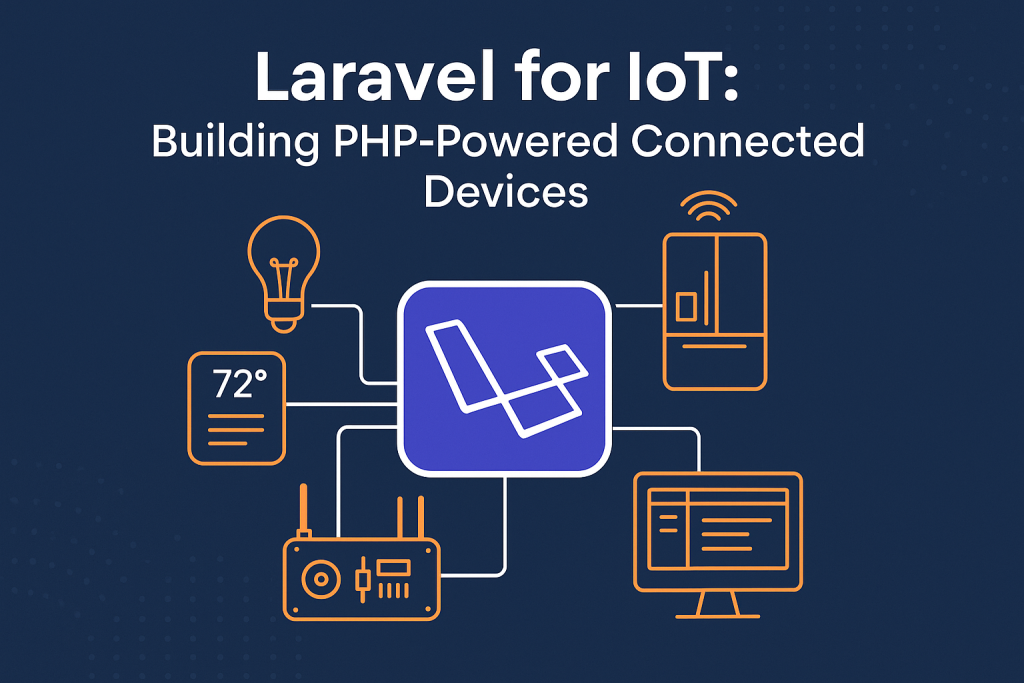
Laravel Meets the Internet of Things
Laravel is one of the most popular PHP frameworks used to build web applications—and now, it’s entering the world of IoT (Internet of Things). From smart thermostats to connected fridges, IoT is changing how we live. But what if you could use Laravel to manage and power these smart devices?
Sounds futuristic? Not anymore. Laravel offers a clean, flexible, and scalable foundation for building IoT-powered applications. Whether you’re a developer or a business owner, integrating Laravel into IoT projects can simplify backend development while enhancing performance.
In this article, we’ll explore how Laravel fits into the IoT ecosystem, what benefits it brings, and how you can start building connected devices using the PHP framework you already love.
What Is IoT, and Why Does It Matter?
The Internet of Things (IoT) refers to a network of physical devices that connect to the internet to collect and exchange data. These can include home appliances, vehicles, wearables, or even medical devices.
For example, a smart doorbell can send live video to your phone. A fitness tracker can log your steps and upload them to the cloud. These devices rely on software to process and manage data—and that’s where Laravel can play a vital role.
Laravel’s structured code, MVC architecture, and built-in tools make it an ideal candidate for IoT backends. While it doesn’t run on microcontrollers (like Arduino), it serves as a powerful server-side companion to handle data, user management, analytics, and more.
Why Use Laravel for IoT Projects?
Here’s why Laravel stands out in the IoT development space:
1. Rapid Development with Clean Code
Laravel comes with built-in tools like Eloquent ORM, Blade templating, and Laravel Mix. These simplify development and reduce the time needed to build robust systems.
2. Built-in API Support
Most IoT devices communicate via REST APIs or MQTT. Laravel’s routing and middleware features make building secure, flexible APIs a breeze.
3. Scalability for Thousands of Devices
IoT projects often grow quickly. Laravel supports modular architecture and can be scaled horizontally with tools like Laravel Octane and Horizon.
4. Security Comes Standard
From CSRF protection to encrypted sessions, Laravel includes everything needed to keep sensitive device and user data safe.
5. Cloud and Edge-Friendly
Laravel works great with AWS, Azure, and Google Cloud. This means it can run centralized dashboards or connect with edge computing nodes to support low-latency use cases.
Key Components of an IoT System Using Laravel
Let’s break down how Laravel fits into an IoT architecture:
1. IoT Devices (Sensors or Actuators)
These are hardware components that sense data (like temperature) or act on commands (like turning on a light).
2. Communication Protocol (MQTT or HTTP)
Devices usually talk to the server using lightweight protocols. Laravel handles HTTP natively and can work with MQTT brokers like Mosquitto through packages.
3. Laravel API Backend
This is the brain of the system. Laravel receives data, stores it in a database, processes it, and sends back responses.
4. Database
Use MySQL, PostgreSQL, or even Redis with Laravel to store sensor readings, logs, or device states.
5. Web Dashboard
Laravel can serve dashboards where users monitor device activity or trigger actions. With Vue.js (included in Laravel Breeze or Jetstream), you can make this interactive and real-time.
Real-World Use Case: Smart Farming
Imagine a farm using soil moisture sensors to optimize irrigation. Here’s how Laravel could support this:
- Sensors collect moisture data and send it via HTTP.
- Laravel receives the data through an API endpoint.
- The backend logs the data, checks thresholds, and sends alerts if moisture drops too low.
- A farmer logs in to a Laravel-powered dashboard to view real-time readings.
- Laravel triggers an automated command to turn on irrigation if needed.
It’s a simple but effective way to save water, time, and money—all powered by Laravel.
How to Build an IoT Backend with Laravel: Step-by-Step
Let’s walk through the basic steps of creating an IoT backend using Laravel.
Step 1: Install Laravel
Use Composer to set up your Laravel project:
composer create-project laravel/laravel iot-backendStep 2: Create API Routes
Define routes for devices to send data:
Route::post('/device/data', [DeviceController::class, 'store']);Step 3: Create a Controller
Process incoming data and store it:
public function store(Request $request) {
DeviceData::create([
'device_id' => $request->device_id,
'temperature' => $request->temperature,
'humidity' => $request->humidity,
]);
return response()->json(['status' => 'success']);
}Step 4: Use Laravel Sanctum or Passport
Secure your APIs so only trusted devices can access them.
Step 5: Display Data in a Dashboard
Use Laravel Livewire or Inertia.js with Blade or Vue to build a dynamic dashboard.
Best Practices for Laravel IoT Projects
Follow these guidelines to make your Laravel IoT app efficient and secure:
- Rate-Limit Device Requests: Use Laravel middleware to prevent spamming.
- Validate Every Input: Never trust incoming device data blindly.
- Use Queues: Offload heavy tasks like analytics or notifications to queues with Laravel Horizon.
- Encrypt Sensitive Data: Protect sensor logs and user info using Laravel’s built-in encryption.
- Log Everything: Laravel’s logging tools help track down issues quickly.
Common Mistakes and How to Avoid Them
Even experienced developers fall into these traps:
- Ignoring Latency: Use queues for time-consuming tasks so devices don’t hang.
- Hardcoding Device Logic: Keep business logic in the backend, not on the device.
- No Error Handling: Use Laravel’s try-catch blocks and error views for graceful failure.
- Skipping Auth: Every device and user must be authenticated to prevent data leaks.
Laravel + MQTT: Real-Time Communication for IoT
While REST APIs are fine, MQTT is faster and better for IoT because it uses a publish-subscribe model.
Laravel can’t act as an MQTT broker, but it can communicate with one. Use official PHP MQTT clients like php-mqtt/client and integrate it into Laravel to subscribe to messages or publish commands.
You can also run a service like Mosquitto on the same server and let Laravel consume messages using scheduled jobs or workers.
Laravel Tools That Help with IoT
Laravel’s ecosystem includes powerful tools perfect for IoT use:
- Laravel Horizon – Manage your queues visually
- Laravel Telescope – Debug and monitor API activity
- Laravel Sanctum – Token-based authentication for devices
- Laravel Livewire – Build interactive dashboards
- Laravel Scheduler – Schedule device checks or reports
All of these are officially supported and regularly maintained.
When Not to Use Laravel for IoT
Laravel is a great choice for many things—but not everything. Here’s when to consider alternatives:
- Embedded Development: Laravel doesn’t run on microcontrollers. Use C++ or MicroPython for device firmware.
- Ultra-Low Latency: For real-time operations at the millisecond level, use edge computing tools closer to the device.
- Offline Scenarios: Laravel needs an internet connection. Offline-first apps may require alternative local setups.
However, for most web-connected device management and dashboards, Laravel is an excellent backend choice.
Conclusion: Laravel’s Role in the Future of IoT
Laravel makes IoT development easier, faster, and more accessible to PHP developers. While it doesn’t replace embedded software, it shines as the backend brain of any IoT project.
With robust APIs, built-in security, and a vibrant ecosystem, Laravel helps bridge the gap between hardware and the cloud. From agriculture to healthcare to home automation, it’s helping businesses innovate smarter.
Want to explore more? Visit the official Laravel documentation to get started with building your IoT backend today.

